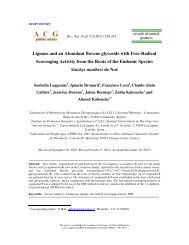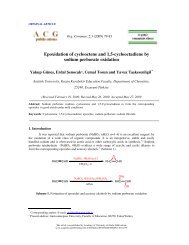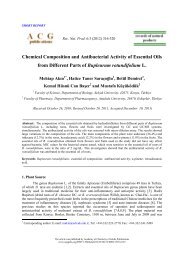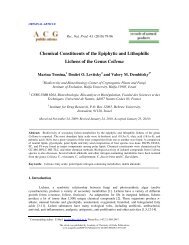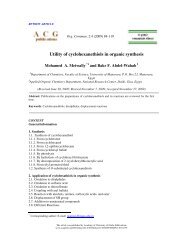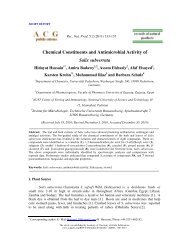Evaluation of Antioxidant Activities of Bergenia ciliata Rhizome
Evaluation of Antioxidant Activities of Bergenia ciliata Rhizome
Evaluation of Antioxidant Activities of Bergenia ciliata Rhizome
You also want an ePaper? Increase the reach of your titles
YUMPU automatically turns print PDFs into web optimized ePapers that Google loves.
47Rajkumar et al, Rec. Nat. Prod. (2010) 4:1 38-48AcknowledgementThe authors gratefully acknowledge Mr. C. Sathyanarayanan, Arya Vaidya Pharmacy(Coimbatore) Ltd., Kanjikode, Palakkad, India for his active support. The authors also thank themanagement <strong>of</strong> VIT University, Vellore for providing the necessary facilities for this research.References:[1] B. Halliwell, J.M.C. Gutteridge and C.E. Cross (1992). Free radicals, antioxidants and human disease:where are we now? J Lab Clin Med. 119, 598-620.[2] D.J. Lefer and D.N. Grander (2000). Oxidative stress and cardiac disease. Am J Med. 109, 315-323.[3] N. Ito, M. Hiroze, G. Fukushima, H. Tauda, T. Shira and M. Tatematsu (1986). Studies on antioxidant;their carcinogenic and modifying effects on chemical carcinogensis. Food Chem Toxicol. 24, 1071-1081.[4] Y.F. Sasaki, S. Kawaguchi, A. Kamaya, M. Ohshita, K. Kabasawa, K. Iwama, K. Taniguchi and S. Tsuda(2002). The comet assay with 8 mouse organs: results with 39 currently used food additives. Mutat Res-Gen Tox En. 519, 103-119.[5] S. Sinha, T. Murugesan, K. Maiti, J.R. Gayen, B. Pal, M. Pal and B.P. Saha (2001). Antibacterial activity<strong>of</strong> <strong>Bergenia</strong> <strong>ciliata</strong> rhizome. Fitoterapia 72(5), 550-552.[6] S. Sinha, T. Murugesan, M. Pal and B.P Saha (2001). <strong>Evaluation</strong> <strong>of</strong> anti-tussive activity <strong>of</strong> <strong>Bergenia</strong><strong>ciliata</strong> Sternb. rhizome extract in mice. Phytomedicine 8(4), 298-301.[7] M. Islam, I. Azhar, U. Khan, M. Aslam, A. Ahmad and Shahbuddin (2002). Bioactivity evaluation <strong>of</strong><strong>Bergenia</strong> <strong>ciliata</strong>. Pak J Pharm Sci. 15(1), 15-33.[8] E. Lister and P. Wilson (2001). Measurement <strong>of</strong> total phenolics and ABTS assay for antioxidant activity(personal communication). Crop Research Institute, Lincoln, New Zealand.[9] A. Yildirim, A. Mavi and A.A. Kara (2001). Determination <strong>of</strong> antioxidant and antimicrobial activities <strong>of</strong>Rumes crispus L. extracts. J Agr. Food Chem. 49, 4083-4089.[10] M.S. Blois (1958). <strong>Antioxidant</strong> determinations by the use <strong>of</strong> stable free radical. Nature 81, 1199-2000.[11] B. Halliwell and J.M.C. Gutteridge (1999). Free radicals in biology and medicine. 3 rd edition, OxfordUniversity Press, Oxford, UK.[12] NIH (1985). Principles <strong>of</strong> laboratory care. NIH publication 85-23, NIH, Bethesda, MD.[13] S.M. Klein, G. Cohen and A.I. Cederbaum (1981). Production <strong>of</strong> formaldehyde during metabolism <strong>of</strong>dimethyl sulphoxide by hydroxyl radical generating system. Biochem. 20, 6006-6012.[14] A. Russo, A.A Izzo, V. Cardile, F. Borrelli and A. Vanella (2001). Indian medicinal plants as antiradicalsand DNA cleavage protector. Phytomedicine 8 (2), 125-132.[15] Y.S. Velioglu, G. Mazza, L. Gao and B.P. Oomah (1998). <strong>Antioxidant</strong> activity and total polyphenolics inselected fruits, vegetables, and grain products. J Agr Food Chem. 46, 4113-4117.[16] Y. Choi, H.S. Jeong and J. Lee (2007). <strong>Antioxidant</strong> activity <strong>of</strong> methanolic extracts from some grainsconsumed in Korea. Food chem. 103, 130-138.[17] S. Meir, J. Kanner, B. Akiri and S.P. Hadas (1995). Determination and involvement <strong>of</strong> aqueous reducingcompounds in oxidative defense systems <strong>of</strong> various senescing leaves. J Agr Food Chem. 43, 1813-1815.[18] P. Siddhuraju, P.S. Mohan and K. Becker (2002). Studies on the antioxidant activity <strong>of</strong> Indian Laburnum(Cassia fistula L.): a preliminary assessment <strong>of</strong> crude extracts from stem bark, leaves, flowers and fruitpulp. Food Chem. 79, 61-67.[19] G.C. Yen, P.D. Duh and C.L. Tsai (1993). Relationship between antioxidant activity and maturity <strong>of</strong>peanut hulls. J Agr Food Chem. 41, 67-70.[20] J. Javanmardi, C. Stushn<strong>of</strong>f, E. Locke and J.M. Vivanco (2003). <strong>Antioxidant</strong> activity and total phenoliccontent <strong>of</strong> Iranian Ocimum accessions. Food Chem. 83, 547-550.[21] M.S Bagul, M.N Ravishankara, H. Padh and M. Rajani, (2003). Phytochemical evaluation and free radicalscavenging properties <strong>of</strong> rhizome <strong>of</strong> <strong>Bergenia</strong> <strong>ciliata</strong> (Haw) Sternb. J Nat Rem. 3, 83-89.[22] B. Halliwell, R. Aeschbach, J. Loliger and O.I. Aruoma (1995). The characterization <strong>of</strong> antioxidants.Food Chem Toxicol. 33, 601-617.[23] L.J. Marnett (1999). Lipid peroxidation-DNA damage by malondialdehyde. Mutat Res. 424, 83-95.[24] P. Hochestein and A.S. Atallah (1988). The nature <strong>of</strong> oxidant and antioxidant systems in the inhibition <strong>of</strong>mutation and cancer. Mutat Res. 202, 363-375.



